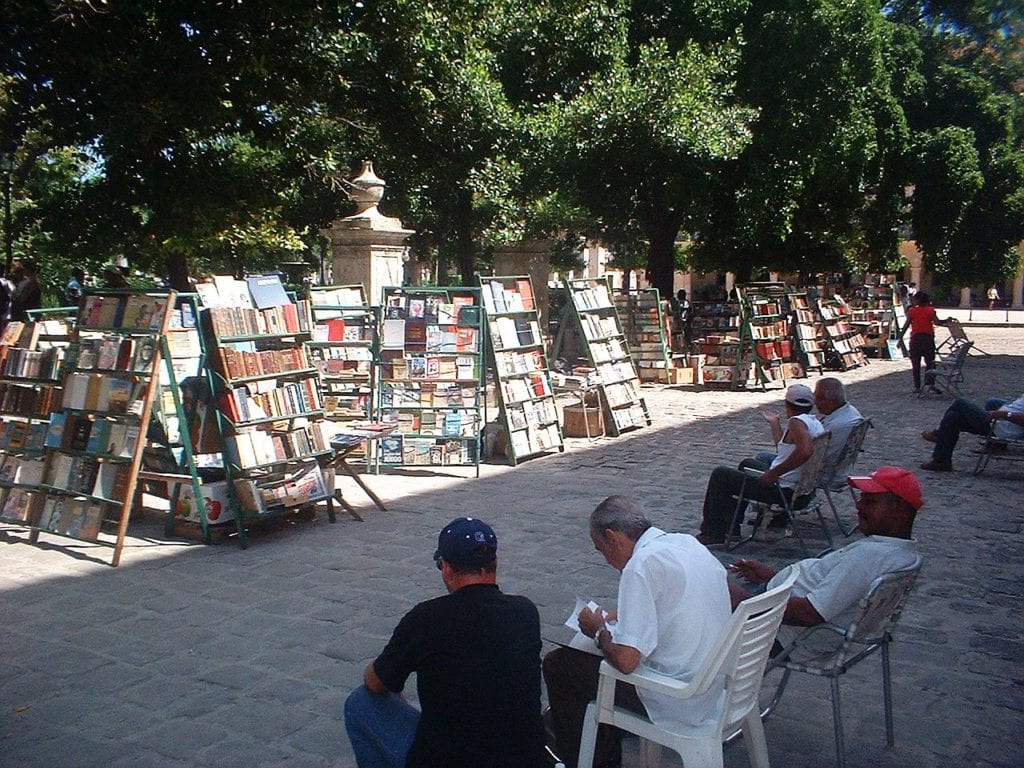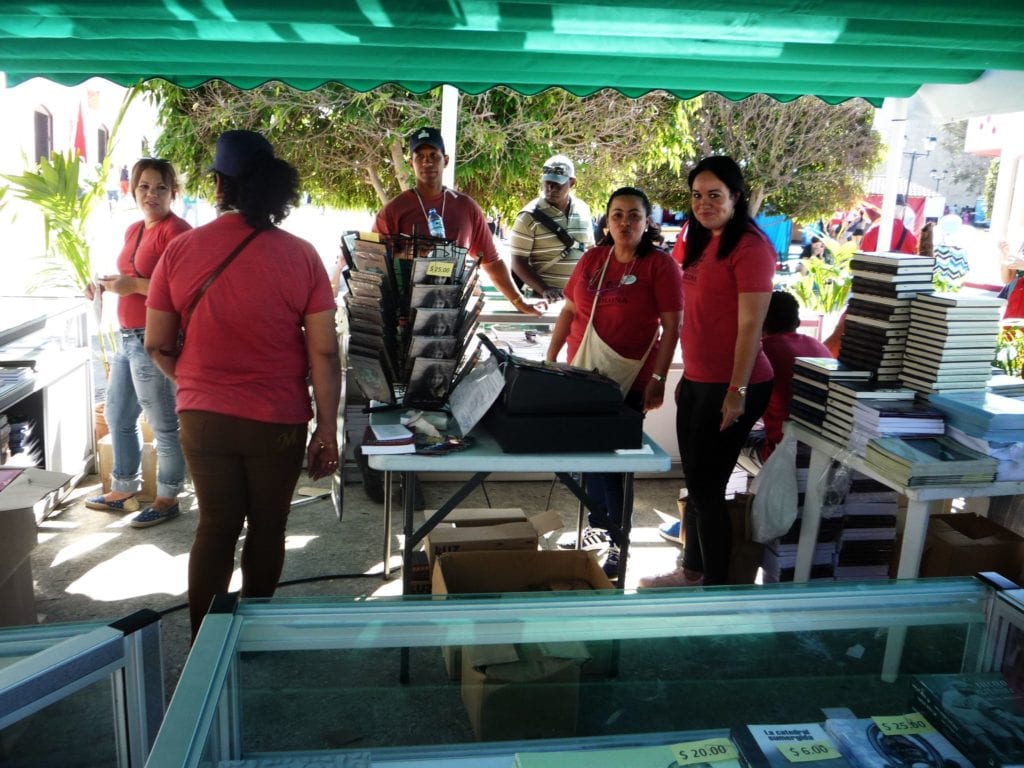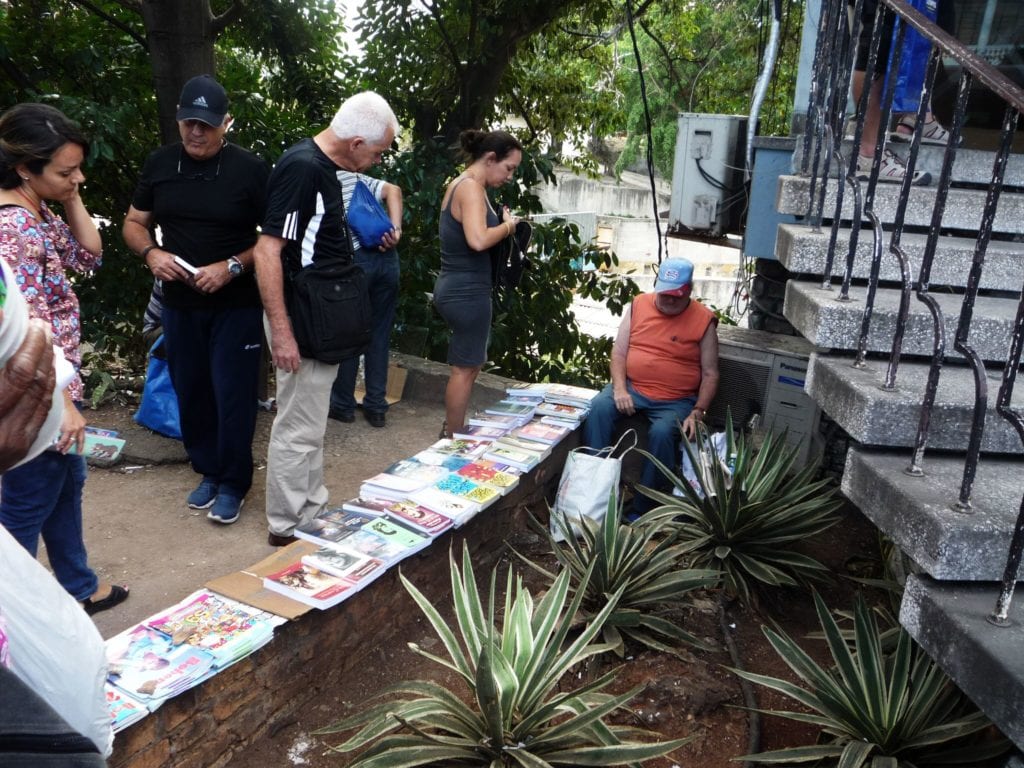Havana’s Culture and Dust Merchants
In this Internet, email and multimedia era, the second-hand booksellers continue to be faithful Guttenberg followers and give a picturesque touch to Havana.
Text and photos By Richard Potts

HAVANA TIMES – In front of the old Palace of the General Captains, in the Plaza de Armas in Old Havana, the used booksellers give a picturesque touch to one of the most popular places for international tourism.
As I contemplate them, I recall those legendary Parisian “bouquiniers”, who on the banks of the Seine turn the old trade of selling into an art, or the booksellers of Cuesta Moyano, in front of the Retiro Park in Madrid.
Although there were some state-owned used bookstores before, nobody knows exactly how the old tradition in Havana spread, when the informal sale of second-hand books began to invade squares, portals and streets. Some experts think that with the collapse of the socialist bloc, and the lack of financing paralyzed almost all Cuban publishers, some citizens saw a commercial opportunity in the resale of used books.
As a curious fact, from 1959 to 1999 more than 30,000 titles were published in Cuba in all literary genres, with more than 900 million copies, according to data from the Cuban Book Institute, not counting thousands of other imported titles.
Therefore, in Cuba the used book abounds, in a country where the immense majority of the population knows how to read and write, and illiteracy is less than 1%. Thus, the informal resale was extended to portals and streets, where characters sometimes worthy of a Victor Hugo novel expose their merchandise.
They can be seen in centric corners, where they plant their platforms or spread old newspapers on the ground to place their treasures, among which almost anything printed can be found: Old universal histories, volumes of the Uteha Encyclopedia, books of the Selections Library, secretarial and shorthand courses, love and detective novels, old and modern magazines.

From the great classics to the mass consumption literature, everything can assail the eyes of the stroller from the platform of the second-hand bookseller., I met some amazing people like Eustaquio. When someone asks for prices, he mentions an exorbitant one, because Eustaquio is a “rare bird” of bookish commerce, with a love so endearing for the printed word that he seems dislike to sell his books, that nobody knows for what arcane reasons, he exhibits at a Havana park.
The government also maintained a few buying and selling bookstores, visited by bibliographers, but the real “boom” was in the early 1990s with the tourism growing, when the used booksellers discovered that foreign visitors were potential customers, and as soon as 200 private labor activities were legalized, the used bookseller reappeared legitimated among them.
The result is seen in Colonial Havana and other tourist spots, where the old portal vendor has been replaced by merchants who often speak English, French or Italian, enough to understand about prices and titles.
In Cuba there are retired professionals in collateral activities like this, in order to increase their income. “Nobody gets rich here,” says Jose Luis, a retired architect, “but we get an extra profit for the family economy.”
“The problem,” says Augusto, from the adjoining stage, “is that tourists do not want to pay for what our merchandise is really worth. Because this is a third world country, they expect to find everything cheaper than in their own. ”

All the booksellers pay a tax to the government, established for independent work activities. As for the profit, the majority affirms that it can be very variable. “But we make a living – said Pedro, a retired lawyer – and in addition I love books and to rescue many that otherwise would disappear.”
Among the most requested titles are some contemporaries: “El diario del Che”, “Fidel y la religion” and books by Cuban and Latin American writers and poets such as Alejo Carpentier, Julio Cortazar, Gabriel Garcia Marquez and Mario Benedetti.
Other popular subjects are texts about plastic arts, colonial architecture, music and other topics that foreign specialists tend to look for, such as essays and research on syncretism cults, folklore and Afro-Cuban religions. In this last subject, the favorite authors are the late Fernando Ortiz and the more contemporary Natalia Bolivar.
Private bookstores have also been established in rented locales, and even in the owner’s own living room in any neighborhood of Havana. With time and the commercial boom, the old booksellers refined their smell, and learned to recognize the value of forgotten books, such as “El ingenio”, by Manuel Moreno Fraginals, to current authors as Dulce Maria Loynaz (The Daughter of the General, Garden), Miguel Barnet (Cimarron, Song of Rachel) or Senel Paz (A King in the Garden), author of the script “Strawberry and Chocolate.”
For others like José Luis, the best-paid books are the rare editions, sometimes a century old, for which a foreign expert can pay well. In this diverse market also enter printed curiosities: Cuban magazines that stopped circulating 40 or 50 years ago, old almanacs, Colonial Havana prints, albums of varied type and even original photos and posters -exhibited in the entries of the cinematographs in the 40s and 50s – of famous US films like “Casablanca” or “An Affair to remember”.
The competition is acute, because there are titles of great demand, published by the tens of thousands in previous decades and that almost all booksellers own, so whoever arrives first at the client, sells first. Among other risks, he must be alert to weather changes, when a sudden tropical rain can ruin his fragile merchandise in this real open-air bookstore.

However, the Cuban booksellers persist. Some are also collectors, and some are really anthological, as Horacio, a true scholar, avid reader, self-taught and shrewd merchant, with a good eye for valuable titles and capable to travel long distances searching for a rare book.
Horacio often leaves his stand with a nephew and leaves for rural villages, after learning that the widow of a lawyer or the children of a writer or engineer, had decided to sell the library created lovingly by the deceased.
Some of these merchants make pitiful blunders. In a plaza in Havana, one tried to sell me a novel in English called “Chain Gang”, which he translated as “la pandilla de los cadeneros” (the gang that uses chains) and it really alluded to the lament of chained convicts.
However, the used bookseller stands always had – and will have – a peculiar charm for collectors: they can take the book, rub it and browse it and enjoy the forgotten pleasure of haggling. In addition, maybe he could find that out-of-print novel so liked in youth, to which time has given greater value.
Sometimes fate plays a trick on them, like the one in a corner of the Vedado neighborhood who asked sixty pesos for an old Roget Thesaurus, recommending it as “very valuable and unavailable title, whose original price was more than one hundred pesos.” Meanwhile, I leafed through the book absentmindedly and in one of its covers I found the receipt of the original purchase, in a vanished Havana bookshop. Smiling I showed it triumphantly to the bookseller: Ten pesos 50 cents, sold on September 11, 1960. I will never forget the expression of the old salesman when he answered reluctantly: “Wow, what a mistake! It’s alright, I lost fair and square. Pay me five pesos and we are at peace. ”
In short, fraudsters or scholars, these used booksellers are the last itinerant merchants of knowledge, and in this Internet, email and multimedia era, still being faithful followers of Guttenberg. In Havana they seem to have returned to stay, as a symbol of an old cultural stamp and a sign of the times.

Richard Potts writes that “can assail the eyes of the stroller “from the great classics to the mass consumption literature”.
So where was there a copy of Dr. Zhivago, undoubtedly one of the classics of the 20th century?
Censorship in Cuba extends into the Plaza de Armas – as indeed it does to the whole of Cuba.
Nice piece by Mr Potts.
Thoroughly enjoyed yr interesting & colourful essay. Books are indeed a window to the past but nonetheless a reflection of current culture, resisting the ever increasing tide of anti social activities. Cheers & regards Richard Potts from John Brock, living in Santiago de Cuba (perhaps a brief encounter at the Casa Granda Terrace a short while ago?)
Hemos,tenido tanta moderation que por eso tenemos 60 a ños de maldicion.En Cuba.
I have visited three times and always, happily, have come away with something. On my last trip, (alas) in 2016, I picked up two “Fresa y Chocolate” film posters – the hands embracing and the ice cream cones versions.
Tourists should stay and visit Xanadu mansion that the french millionaire lived there DuPont Ireen the mansion costs $33,0000 .00 million dollars in 1933, the Hotel Inglaterra is very nice place to stay…
A lot of books were not publushed after 1959 because of the horrible communist repression. Your article suggests that there was an intellectual boom during the brutality if Castro Communism.
Cuba, history-Lights Out: A Cuban Memoir, check it out
Visited the the square in 2013 and bought Our Man In Havana, Graham Greene and The Fisherman and the sea, Hemingway. Great experience. Happy to pay the price.
Yes good please Habana.